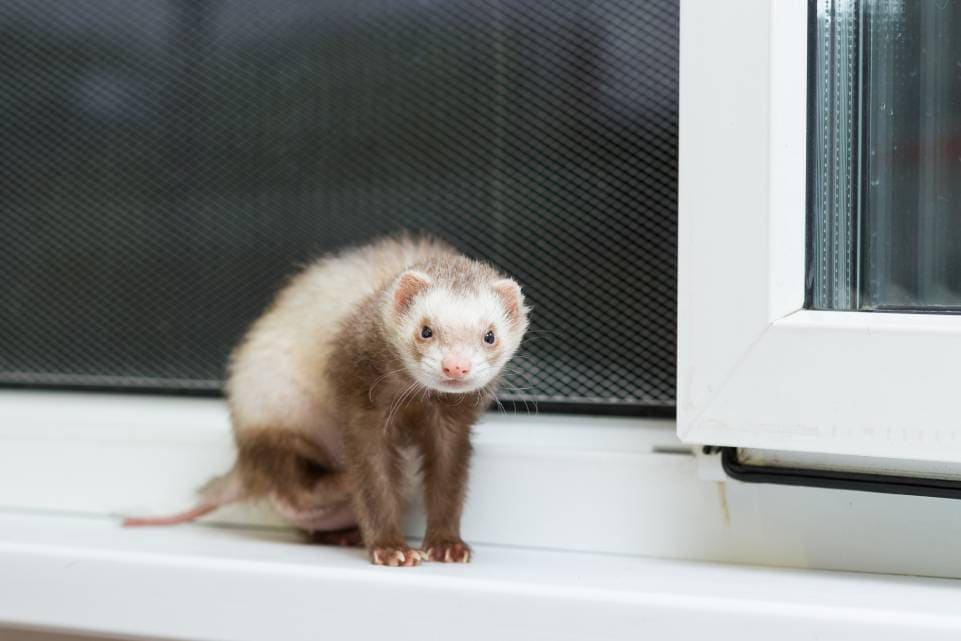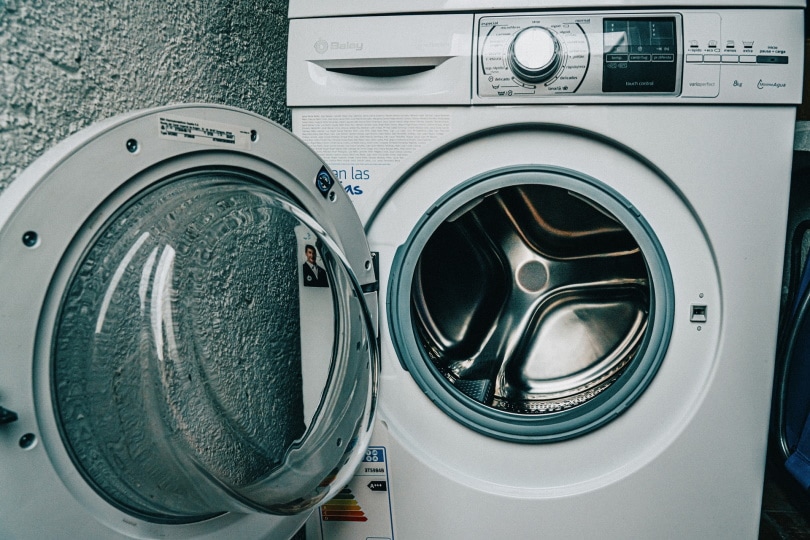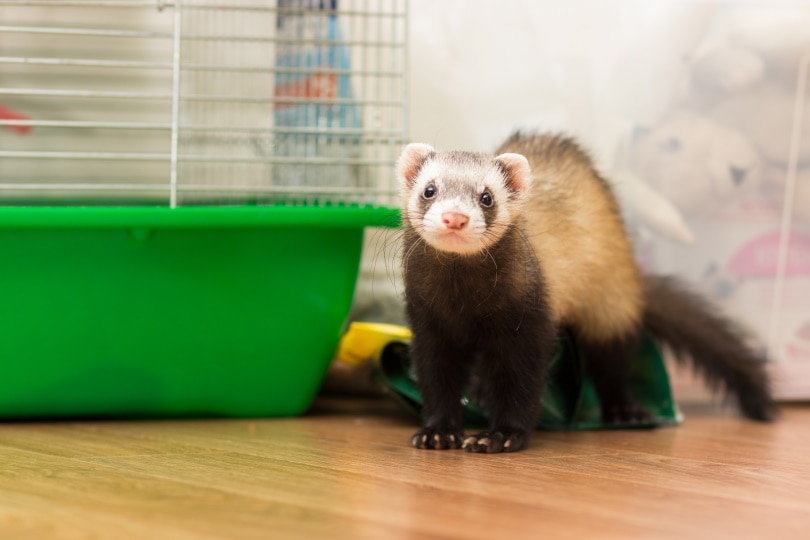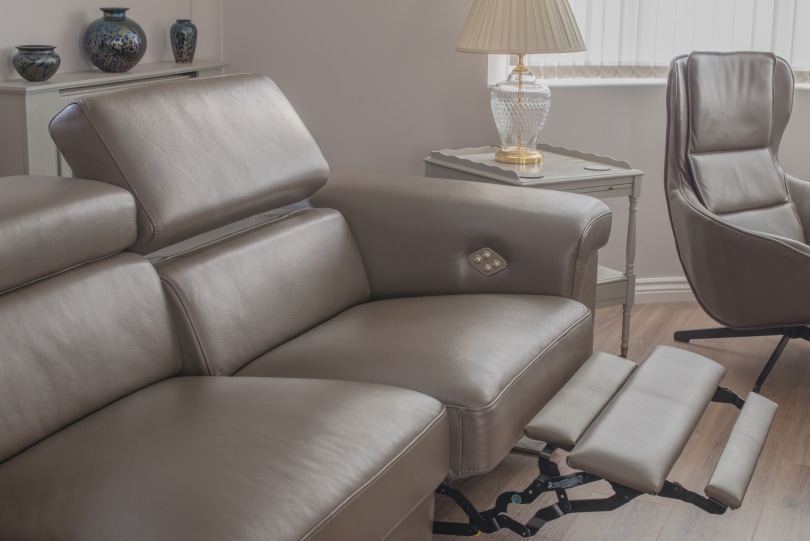
Ferrets are fun, sociable, cute pets. They are also very lively, incredibly inquisitive, and they tend to chew just about anything they can sink their teeth into. Experts advise that ferrets be let out of their cage at least once a day and for around 2 hours at a time, which is a lot of time to explore, potentially make a mess of a room, and get themselves into a world of trouble. Before letting your ferret out for some time exploring, you should ferret proof your house, or an individual room, to ensure their safety and your sanity.
Below are 15 steps to ensure you have a ferret-proof area.
The 15 Steps to Ferret-Proof a Room
1. A Single Room Is Best
There are a lot of potential ferret hazards in a house and your ferret is likely to zip from one room to another, looking for things to explore and places to hide. It is very difficult to monitor a whole house. While there are still hazards in a single room, it is easier to see what your ferret is getting up to and manage all the likely hazards if you can shut off that one room. Although you should always supervise the time your ferret spends out of its cage, having a single room gives you a little more room to breathe.

2. Look for, and Block Off, Ferret Exits
A ferret exit is not the same as a human exit, and these wily little creatures can squeeze through surprisingly small spaces. This includes gaps in windows and even some large gaps under doors. You also need to check around plumbing, for example where pipes come into and out of the kitchen, because there can be gaps left around the pipes. If your ferret can fit its head through a gap, it can almost certainly get its body through after.
3. Block Off Appliances
The plumbing from your appliances isn’t the only potential danger. Many appliances have a small gap underneath and offer access into the motor and internal workings of the device from underneath. This poses a serious potential hazard for the inquisitive ferret, who is prone to chew wires and can make a hiding place in a very small corner of the workings of a washing machine.

4. Cover the Underside of Furniture
Similarly, while the tops of chairs and sofas tend to be well covered, although may still be chewable for a small animal, the underneath can be open and especially inviting to your four-legged friend. If necessary, you might need to cover the underneath of furniture using a thick and impenetrable fabric or other material. If you struggle to find your ferret following an excursion from its cage, it’s worth double-checking under your sofa.
5. Check Your Cushions
Cushions are another potential hidey-hole. Ferrets will look for a potential weak spot in the fabric or areas around the zipper or seam and pick the stitching apart before climbing in. Alternatively, they will hide under cushions, so you should double-check before sitting down to avoid squishing one.

6. Protect Your Mattresses
Mattresses seem tough, but box mattresses, especially, do offer a way in. This is another occasion where it might prove necessary to modify the original design with some of your own fabric covering. It might seem excessive but covering the base of a mattress before your ferret gets in will be a lot easier than retrieving them afterward, and it eliminates the risk of them eating the mattress stuffing and suffering impaction.
7. Remove Edible Objects
Ferrets love to chew and they will chew on just about any material but especially on cushions, foam, rubber, cardboard, wood, and plastic. Hairbands, elastic bands, and rubber dog toys or children’s toys should be removed from your ferret’s grasp, or you run the very risk that they will eat them and potentially block their digestive system.

8. Lock Cleaning Supplies Away
While you’re at it, you should also ensure that there are no cleaning products or other potentially harmful chemicals and substances laying around. This can include shampoos, makeup, and things like bleaches and toilet cleaners. The best approach is to prevent your ferret from going into the bathroom, toilet, and kitchen. Alternatively, lock everything away in a secure closet.
9. Close the Toilet
Any body of water is a potential threat, whether it be a full bath, a toilet, or even a bucket of water. Wild ferrets can swim, and so too do many pet ferrets, but even a capable swimmer will struggle if they are left in a body of water with no obvious or simple means of getting out. If your ferret slips in the toilet it may not be able to scamper out, especially if it panics and causes the lid to close. It isn’t worth the risk.

10. Ensure Cupboard Doors Close Firmly
Ferrets have strong noses, in the sense that they can use them to ably open cupboard doors and move other objects. If you don’t want to spend hours checking every drawer and closet for your little escapee, close cupboard doors and use magnetic or other types of locks so that they are securely closed and impregnable.
11. Avoid Upstairs Railings
Ferrets love climbing up things but aren’t always as adept at descending those objects. They also have seemingly no sense of fear, which means that they will take a leap of faith from the top of high objects, just to get down. In most cases, they will land safely but this isn’t always true. If you have open railings on the upstairs landing, avoid letting your ferret near them or it may simply choose to leap.

12. Put Candles Away and Extinguish Fires
Extinguish candles and always supervise your ferret if you have a fire or other hot heater on. They may be sensible enough to avoid open flames, but it only takes one incident for a really serious burn.
13. Avoid Recliner Chairs
Recliner chairs use gears, strong springs, and other mechanisms within the chair to produce the rise and recline motions. They also have appealing little cubbies in which your ferret thinks it’s a good idea to sit. Unfortunately, these open spaces are where the chair mechanism tends to move to, and if your little one is in the chair when it is used, it can lead to them being squashed. Avoid using recliner chairs until you know exactly where all of your pets are.

14. Check the Washing
Ferrets love to hide, especially in clothing because it is easy to burrow, and it offers plenty of protection from the outside world. If your ferret is out of its cage, check any washing before you put it in the machine, and double-check the machine before you turn it on. Or, better still, wait until the ferret is back in its cage.
15. Constant Supervision
Supervise your ferret when you let it out. They are very inquisitive animals, which can lead to them getting into all kinds of trouble, even when you haven’t necessarily identified an area or an object as being trouble. Keep an eye out, an ear open, and your senses alert to any danger.

How to Ferret-Proof Wires
Ideally, you should bundle loose wires so that they are not loose anymore. Have the cables run along the ceiling rather than the floor. However, even if you do this as much as possible, there will inevitably be some wires that are still accessible and tempting. You can buy special cable covers that are designed to prevent chewing. Alternatively, use a liquid that naturally but safely deters ferrets, and cover the wires in it.
Can You Keep a Ferret in a Bedroom?
Ferrets do naturally smell. This smell tends to be confined to their enclosure but if you don’t clean it daily, it will quickly ruminate around a room. If you do intend to keep your ferret in the bedroom, you are going to have to spend a lot of time litter training, cleaning the litter tray, and ensuring that the enclosure is kept spotless. But it is absolutely possible to keep a ferret in a bedroom.

Can Ferrets Slip Under Doors?
This won’t usually be a problem with external doors, but if there is a gap of an inch or more at the bottom of a door, there is a good chance that your ferret will be able to get under. Use a door gap stopper, designed specifically for this purpose, and don’t rely on door screens because they are no match for determined ferret teeth.
Can You Litter Train a Ferret?
Ferrets have preferred corners that they will use to do their business. As such, this makes it possible to litter train your little pet. Place the litter tray in a corner. If your ferret urinates or defecates in another area, move the tray there. If it goes somewhere else, move the box again. As long as you are consistent, it shouldn’t take too long before they are using the litter tray every time. When this happens, you can even move the litter tray out of the enclosure with your ferret, to avoid getting pee and poop on the floor.
Final Thoughts
Ferret proofing a single room is a more reliable and effective method of protecting your ferret and your belongings than attempting to proof an entire house. It enables you to prevent and restrict access to things like candles and toilets, which are a natural hazard, and it means less work on your part. Remember, though, that you should supervise your pet when it is out of its enclosure because ferrets are inquisitive and often mischievous little pets.
Featured Image Credit: Ermolaeva Olga 84, Shutterstock








